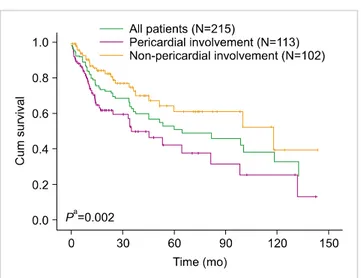237
This is an Open Access article distributed under the terms of the Creative Commons Attribution Non-Commercial License (http://creativecommons.org/licenses/by-nc/3.0) which permits unrestricted non-commercial use, distribution, and reproduction in any medium, provided the original work is properly cited.
Table 1. Etiological diagnosis and frequency of pericardial involvement in malignant diseases.
Malignancies Patients, N (%) Patients with pericardial involvement, N (%)
Solid tumors Lung adenocarcinoma 105 (48.8) 65 (61.9)
Ductal cell carcinoma, breast 20 (9.3) 17 (85.0)
Gastric adenocarcinoma 17 (7.9) 10 (58.8)
Esophageal squamous cell carcinoma 17 (7.9) 3 (17.6)
Hepatocellular carcinoma 11 (5.1) 1 (9.1)
Cholangiocarcinoma 3 (1.4) 0 (0.0)
Thymic carcinoma 9 (4.2) 3 (33.3)
Other solid tumorsa) 23 (10.7) 9 (39.1)
Hematological malignancies Lymphoma 6 (2.8) 5 (83.3)
Other hematologic malignanciesb) 4 (1.9) 0 (0.0)
Total 215 (100.0) 113 (52.6)
a)Angiosarcoma (N=2), cervix cancer (N=1), colorectal cancer (N=4), embryonal carcinoma (N=1), endodermal sinus tumor (N=2), endomertrial cancer (N=1), glottic cancer (N=1), metastatic cancer of unknown origin (N=1), neuroblastoma (N=3), osteosarcoma (N=1), rhabdomyosarcoma (N=1), saivary duct carcinoma (N=1), sarcomatoid carcinoma (N=1), synovial sarcoma (N=1), thyroid cancer (N=2),
b)Acute myeloid leukemia (N=2), chronic myelogenous leukemia (N=1), myelodysplastic syndrome (N=1).
http://dx.doi.org/10.5045/kjh.2012.47.3.237 The Korean Journal of Hematology Volume 47ㆍNumber 3ㆍSeptember 2012
Letter to the Editor
Prognostic relevance of pericar- dial effusion in patients with ma- lignant diseases
TO THE EDITOR: Malignancy is a common cause of peri- cardial effusion, and malignant pericardial effusion is a seri- ous manifestation in advanced malignancies [1]. Malignancy- related pericardial effusion is associated with significantly decreased patient survival [1]. Slight malignant pericardial effusions are frequently asymptomatic; however, sympto- matic patients often present with cardiac tamponade, which can rapidly lead to cardiovascular collapse or death [2].
Therefore, early diagnosis and timely treatment may de- crease a patient’s short-term risk of death. We evaluated both the etiology and prognosis of pericardial involvement in several malignancies.
We retrospectively reviewed the records of 215 patients (126 males and 89 females) with pericardial effusion and malignant diseases, including solid tumors and hemato- logical malignancies, from January 1991 to December 2010.
In all cases, the clinical diagnosis was confirmed by patho- logical examination of the primary tumor site. All patients underwent pericardiocentesis, and pericardial fluid analyses were performed for cytology. We analyzed the incidence of the etiology of malignancies and overall survival accord- ing to the results of the pericardial fluid analysis. Overall survival was calculated from the day of initial diagnosis to the date of patient’s death from any other cause or to the latest follow-up date.
Among 215 patients, 113 (52.6%) showed pericardial in- volvement in their malignant diseases. The etiological diag- nosis and pericardial fluid analysis results are summarized in Table 1. Pericardial involvement of malignancy was most frequent in breast carcinoma (85.0%), followed by lung adenocarcinoma (61.9%), gastric adenocarcinoma (58.8%), thymic carcinoma (33.3%), and esophageal squamous cell
Korean J Hematol 2012;47:237-8.
238 Letter to the Editor
Fig. 1. Overall survival according to pericardial involvement in the malignant disease. The pericardial involvement group had a signi- ficantly poorer survival rate than the non-pericardial involvement group (Pa, pericardial involvement group vs. non-pericardial involvement group).
carcinoma (17.6%). In a survival analysis using the Cox proportional hazards model, the pericardial involvement group showed significantly poorer survival rates than the non-pericardial involvement group (hazard ratio, 2.157; 95%
confidence interval, 1.327-3.507; P=0.002). The median sur- vival time was significantly longer in patients with no evi- dence of pericardial involvement in their malignant diseases than in those with pericardial involvement in malignancy (118.2 months vs. 34.8 months; P=0.001) (Fig. 1).
In studies, the most common cause of malignant peri- cardial effusion was lung cancer (34-76%), followed by breast cancer (10-17%) [1, 3, 4]. However, in the present study, ductal cell carcinoma of the breast had the highest incidence of pericardial involvement. Because our study population included only patients with advanced-stage breast cancer, the incidence of their pericardial involvement
is not representative of all patients with breast cancer.
Several treatment modalities, including both medical and surgical modalities, have been proposed for malignant peri- cardial effusion [5]. Timely management of pericardial effu- sion is important to improving the clinical outcome.
In conclusion, patients with pericardial involvement in their malignant diseases had a relatively poorer prognosis than those without pericardial involvement in malignant diseases. Cautious morphologic analyses of pericardial fluid are recommended before application of palliative or ther- apeutic pericardiocentesis, especially in patients with lung or breast carcinoma.
Tae-Dong Jeong, M.D., Seongsoo Jang, M.D., Ph.D., Chan-Jeoung Park, M.D., Ph.D., Hyun-Sook Chi, M.D., Ph.D.
Department of Laboratory Medicine, Asan Medical Center, University of Ulsan College of Medicine, 88, Olympic-ro 43-gil, Songpa-gu, Seoul 138-736, Korea Tel: +82-2-3010-4502, E-mail: hschi@amc.seoul.kr
1. Gornik HL, Gerhard-Herman M, Beckman JA. Abnormal cytol- ogy predicts poor prognosis in cancer patients with pericardial effusion. J Clin Oncol 2005;23:5211-6.
2. Halfdanarson TR, Hogan WJ, Moynihan TJ. Oncologic emergen- cies: diagnosis and treatment. Mayo Clin Proc 2006;81:835-48.
3. Dequanter D, Lothaire P, Berghmans T, Sculier JP. Severe peri- cardial effusion in patients with concurrent malignancy: a retro- spective analysis of prognostic factors influencing survival. Ann Surg Oncol 2008;15:3268-71.
4. Kim SH, Kwak MH, Park S, et al. Clinical characteristics of malig- nant pericardial effusion associated with recurrence and survival.
Cancer Res Treat 2010;42:210-6.
5. Maisch B, Ristic A, Pankuweit S. Evaluation and management of pericardial effusion in patients with neoplastic disease. Prog Cardiovasc Dis 2010;53:157-63.

